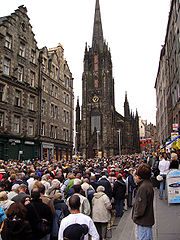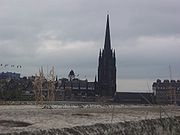
The Hub (Edinburgh)
Encyclopedia


Edinburgh
Edinburgh is the capital city of Scotland, the second largest city in Scotland, and the eighth most populous in the United Kingdom. The City of Edinburgh Council governs one of Scotland's 32 local government council areas. The council area includes urban Edinburgh and a rural area...
's Royal Mile
Royal Mile
The Royal Mile is a succession of streets which form the main thoroughfare of the Old Town of the city of Edinburgh in Scotland.As the name suggests, the Royal Mile is approximately one Scots mile long, and runs between two foci of history in Scotland, from Edinburgh Castle at the top of the Castle...
, is the home of the Edinburgh International Festival
Edinburgh International Festival
The Edinburgh International Festival is a festival of performing arts that takes place in the city of Edinburgh, Scotland, over three weeks from around the middle of August. By invitation from the Festival Director, the International Festival brings top class performers of music , theatre, opera...
, and a central source of information on all the Edinburgh Festival
Edinburgh Festival
The Edinburgh Festival is a collective term for many arts and cultural festivals that take place in Edinburgh, Scotland each summer, mostly in August...
s. Its gothic
Gothic architecture
Gothic architecture is a style of architecture that flourished during the high and late medieval period. It evolved from Romanesque architecture and was succeeded by Renaissance architecture....
spire - the highest point in central Edinburgh - towers over the surrounding buildings, including the adjacent castle
Edinburgh Castle
Edinburgh Castle is a fortress which dominates the skyline of the city of Edinburgh, Scotland, from its position atop the volcanic Castle Rock. Human habitation of the site is dated back as far as the 9th century BC, although the nature of early settlement is unclear...
. The building was designed in collaboration by Edinburgh architect J Gillespie Graham
James Gillespie Graham
James Gillespie Graham was a Scottish architect, born in Dunblane. He is most notable for his work in the Scottish baronial style, as at Ayton Castle, and he worked in the Gothic Revival style, in which he was heavily influenced by the work of Augustus Pugin...
, and the famous gothic revivalist Augustus Pugin
Augustus Pugin
Augustus Welby Northmore Pugin was an English architect, designer, and theorist of design, now best remembered for his work in the Gothic Revival style, particularly churches and the Palace of Westminster. Pugin was the father of E. W...
, and constructed between 1842 and 1845.
The inside houses the Hub Cafe; Hub Tickets, the central box office for the International Festival, which also sells tickets for a wide range of other events; a Main Hall with a capacity of 420, used as a venue for concerts and so on; and two smaller venues, the Glass Room and the Dunard Library, suitable for smaller events.
Prior to the completion of the new Scottish Parliament Building
Scottish Parliament Building
The Scottish Parliament Building is the home of the Scottish Parliament at Holyrood, within the UNESCO World Heritage Site in central Edinburgh. Construction of the building commenced in June 1999 and the Members of the Scottish Parliament held their first debate in the new building on 7...
at Holyrood in 2004, the Hub was occasionally used for meetings of the Scottish Parliament
Scottish Parliament
The Scottish Parliament is the devolved national, unicameral legislature of Scotland, located in the Holyrood area of the capital, Edinburgh. The Parliament, informally referred to as "Holyrood", is a democratically elected body comprising 129 members known as Members of the Scottish Parliament...
when the Church of Scotland's General Assembly Hall was unavailable. The Parliament returned to the Hub for two weeks following the collapse of a beam in its debating chamber on 2 March 2006.
Previous use as a church
What is now "The Hub" was built for the Church of ScotlandChurch of Scotland
The Church of Scotland, known informally by its Scots language name, the Kirk, is a Presbyterian church, decisively shaped by the Scottish Reformation....
both as a parish church and as a purpose-built General Assembly Hall
Assembly Hall
An assembly hall is traditionally a building used for the purposes of holding deliberative assemblies. An example is the Assembly Hall where the general assembly of the state of Mississippi was held. Some Christian denominations call their meeting places or places of worship, assembly halls, such...
. It was originally known as the Victoria Hall. The General Assembly of the Church of Scotland
General Assembly of the Church of Scotland
The General Assembly of the Church of Scotland is the sovereign and highest court of the Church of Scotland, and is thus the Church's governing body[1] An Introduction to Practice and Procedure in the Church of Scotland, A Gordon McGillivray, 2nd Edition .-Church courts:As a Presbyterian church,...
last met here in 1929, when the Church of Scotland united with the United Free Church of Scotland
United Free Church of Scotland
The United Free Church of Scotland is a Scottish Presbyterian denomination formed in 1900 by the union of the United Presbyterian Church of Scotland and the Free Church of Scotland...
, thereafter using the former United Free Church's Assembly Hall on The Mound
The Mound
The Mound is an artificial hill in central Edinburgh, Scotland, which connects Edinburgh's New Town and Old Town. It was formed by dumping around 1,501,000 cartloads of earth excavated from the foundations of the New Town into the drained Nor Loch which forms today's Princes Street Gardens. The...
(and continuing to this day.)
In 1979 the Highland Tolbooth St John's Church building was closed, the congregation uniting with the nearby Greyfriars Kirk
Greyfriars Kirk
Greyfriars Kirk, today Greyfriars Tolbooth & Highland Kirk, is a parish kirk of the Church of Scotland in central Edinburgh, Scotland...
. The congregation had been notable for its services in Gaelic
Scottish Gaelic language
Scottish Gaelic is a Celtic language native to Scotland. A member of the Goidelic branch of the Celtic languages, Scottish Gaelic, like Modern Irish and Manx, developed out of Middle Irish, and thus descends ultimately from Primitive Irish....
as well as English. The building was then virtually unused until becoming "The Hub".

